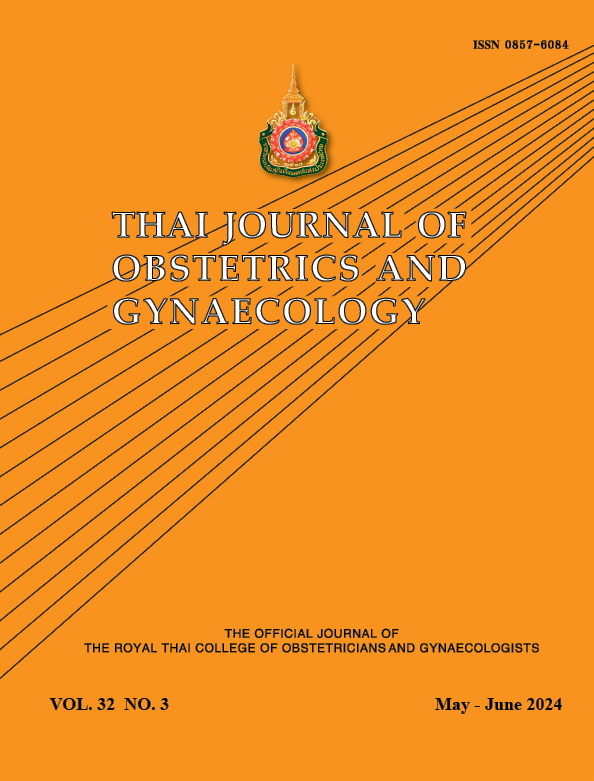Prevalence and Factors Associated with High Postpartum Depression Score Using Thai Edinburgh Postnatal Depression Scale in Charoenkrung Pracharak Hospital
Main Article Content
Abstract
Objectives: This study aimed to estimate the prevalence of high postpartum depression score at 6-week postpartum using Thai Edinburgh postnatal depression scale (EPDS).
Materials and Methods: This cross-sectional study was conducted in December 2022 - May 2023. Two hundred and ninety-four participants were included. Personal data and obstetrics outcome of participants were collected on the 2nd day and 6-week of the postpartum period. Thai version of EPDS was recorded at 6 weeks postpartum. EPDS score at least 11 were considered as high postpartum depression score. Personal data and obstetrics outcome were analyzed by using t-test and regression analysis to identify associating factors.
Results: Of all 264 participants who were followed-up at 6-week postpartum period, it was found that 46 participants had high postpartum depression scores with the prevalence of 17.42%. After multivariate analysis, unintended pregnancy adjusted odds ratio (aOR 2.27, 95% confidence interval (CI) 1.06-4.76), maternity leave (aOR 0.47, 95%CI 0.23-0.99), postpartum stressful event (aOR 4.55, 95%CI 2.13-9.74) and inadequate social support (aOR 5.26, 95%CI 2.33-12.5, p <0.001) were statistically significantly associated with high postpartum depression scores.
Conclusion: The prevalence of high postpartum depression scores at 6 weeks was 17.42%. Healthcare professionals should be aware of postpartum depression and pay extra attention to patients with unintended pregnancy, postpartum stressful event, and inadequate social support. Taking maternity leave may be advocated.
Article Details

This work is licensed under a Creative Commons Attribution-NonCommercial-NoDerivatives 4.0 International License.
References
Cunningham FG, Leveno KJ, Dashe JS, Hoffmanet BL, Spong CY, Casey BM. Williams Obstetrics 26th ed. New York : McGraw Hill 2022:1144-5.
Elwood J, Murray E, Bell A, Sinclair M, Kernohan WG, Stockdale J. A systematic review investigating if genetic or epigenetic markers are associated with postnatal depression. J Affect Disord 2019;253:51-62.
ACOG Committee Opinion No. 757: Screening for perinatal depression. Obstet Gynecol 2018;132: e208-e12.
Resnik R, Lockwood CJ, Moore TR. Creasy & Resnik’s maternal-fetal medicine: Principles and practice. Philadelphia, PA: Elsevier, 2019: 1317-9.
DelRosario G, Chang AC, Lee ED. Postpartum depression: symptoms, diagnosis, and treatment approaches. JAAPA 2013;26:50-4.
American Psychiatric Association. Diagnostic and statistical manual of mental disorders. 5th ed. 2013: 184-213.
Cox JL, Holden JM, Sagovsky R. Detection of postnatal depression. Development of the 10-item Edinburgh Postnatal Depression Scale. Br J Psychiatry 1987;150:782-6.
Vacharaporn K, Pitanupong J, Samangsri N. Development of the Edinburgh postnatal depression scale in Thai version. J Ment Health Thai 2003;11:164-9.
Wang Z, Liu J, Shuai H, Cai Z, Fu X, Liu Y, et al. Mapping global prevalence of depression among postpartum. Transl Psychiatry 2021;11:640.
Chaopanipwet W. Prevalence and associating factors with postpartum depression in General Hospital. JCP 2012;8:12-21.
Naunchawee W, Kasipon T, Nateesombat K. The prevalence of postpartum depression and factors predicting depression in postpartum mothers. HCU J 2018;21:65-78.
Santomauro DF, Herrera AMM, Shadid J, Zheng P, Ashbaugh C, Pigott DM, et al. Global prevalence and burden of depressive and anxiety disorders in 204 countries and territories in 2020 due to the COVID-19 pandemic. Lancet 202;398:1700–12.
Cho H, Lee K, Choi E, Cho HN, Park B, Suh M, et al. Association between social support and postpartum depression. Sci Rep 2022;12:3128.
Thoits PA. Mechanisms Linking social ties and support to physical and mental health. J Health Soc Behav 2011;52:145-61.
Bolger N, Zuckerman A, Kessler RC. Invisible support and adjustment to stress. J Pers Soc Psychol 2000;79:953-61.
Qobadi M, Collier C, Zhang L. The effect of stressful life events on postpartum depression: Findings from the 2009-2011 Mississippi pregnancy risk assessment monitoring system. Matern Child Health J 2016;20:164-72.
Mercier RJ, Garrett J, Thorp J, Siega-Riz AM. Pregnancy intention and postpartum depression: secondary data analysis from a prospective cohort. BJOG 2013;120:1116-22.
Joyce T, Kaestner R, Korenman S. The Stability of pregnancy intentions and pregnancy- related maternal behaviors. Matern Child Health J 2000;4:171–8.
Ranatunga IDJC, Jayaratne K. Proportion of unplanned pregnancies, their determinants and health outcomes of women delivering at a teaching hospital in Sri Lanka. BMC Pregnancy Childbirth 2020;20:667.
Kornfeind KR, Sipsma HL. Exploring the link between maternity leave and postpartum depression. Womens Health Issues 2018;28:321-6.
Figueiredo B, Canário C, Field T. Breastfeeding is negatively affected by prenatal depression and reduces postpartum depression. Psychol Med 2014;44:927-36.
Hamdan A, Tamim H. The relationship between postpartum depression and breastfeeding. Int J Psychiatry Med 2012;43:243-59.


